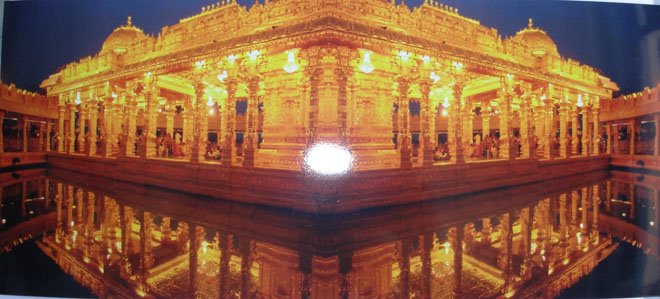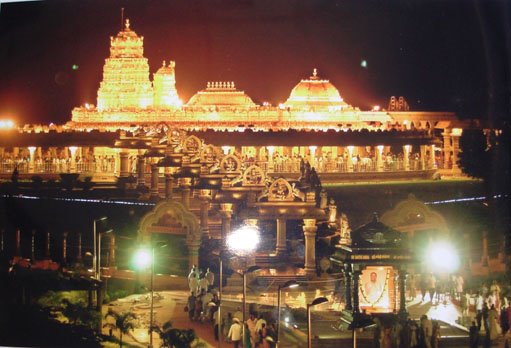
Vellore Fort
Place Name
Vellore was part and parcel of Arcot, which is considered to be a great city even during the Sangam age. The Sangam literature mentions about the richness of Arcot. In one of the literature, written by Paranar, the poet praises the city of Arcot which is about 1900 years old. He says that it was equal to the Chola capital Uraiyur near Trichy. The name Arcot is derived from the nature Aru-Kadu (Six forests) that existed on either side of the river palar. In these six forest, six famous sages said to have been doing penance.
Another version is that there were six varieties of trees existing in these forests and thus the name Arcot is derived from the Tamil work Aru-Kadu. Some others say that the river and the forest ((in Tamil Aarum Kadugalum) together is called as Arcot. Another version is that the forest was full or Arr or Atti (Glamoratta) trees and the name of the people is derived from these Arrtrees as (Arr-Kadu) Arcot.
Raa.Pi. Sethupillai, in his book “Oorum Perum” (Place and Name) mentions that in the olden days, there were Velan (Babool) trees in the heart of the present town and the city in the middle of this dense forest was known as Velapadi. Later when development took place it was called as Velur-Padi which is mentioned in the inscriptions and then changed to its present from as Vellore. Even today a place called as Velapadi is famous ancient part of Vellore Town.
LITERATURE
Velur pathigam also says that this part of the area is known as kurinji Nilam and called as Velur-padi. Arunagirinathar in his Thirupugazh mentions the name of Vellore in several places of his devotional hymns. (Sirupanathupadai 172.3) mentions the name of the town as Velur.
INSCRIPTIONS
On the east of the Vellore town, there is a hill range known as Bavaji hill, and at the foot of this hill, there is an inscription belongs to the Rashtrakuta King Kannaradeva (Krishna III) which mentions the name of the city as Velurpadi (A.D.963, SII-1, No. 51). He has the title of Kachiyum Thanjayum Konda (one who conquered both Kancheepuram and Thanjavur). The Cholavaram inscription (SII-8, no.9) also refers the same name as Velurpadi. The Shenbakkam inscription (SII-1, No.110) directly refers the name of the city as Vellore.
And thus, Vellore is the name of the town from the very early days, and the city must be undoubtly an ancient one.
VELLORE REGION – TOPHOGRAPHY
Vellore and the region around it has rich and varied pre-historic remains. The broad plain in the east of the town strewned with numerous sites yielding vestives of Paleolithic period (from about 3,00,000 years). Many habitations of Neolithic and Iron age culture (from 4,000 to 2000 years) wee located in the hill ranges around Vellore. The entire region is scatterd with many type of megalithic burial tombs (C.2 500 years) known locally as Pandavarkuzhi.
fort, cmc, voorhees
HISTORY
1. Legendary Accounts:
The local tradition embodied in a Tamil Gadjam manuscript. This manuscript history of Vellore, its Fort and temple, was most probably written during the late 18th century and perhaps based on documentation no longer available to us today. The manuscript history, however, has formed the basis for many accounts written on Vellore its Fort and buildings. The authenticity of dates mentioned in the manuscript are very doubtful and unfortunately there is no date, no other documentation which would serve as a cross check. It is interesting to note that even this manuscript history is ot uniformly written. We have three such legendary accounts as follows:
01) The legends about the origin of the temple and Fort is quite interesting. About 450 years ago, one Bomma Reddy, (Bommi Reddy) an inhabitant of the Badavachalam arrived at this place with his brother, enroute to Ramesvaram, and halted for several days at a nearby village. One day accompanied by his dog, he went into a jungle (forest) to look after for some games. All of a sudden a hare assaulted his dog on a particular spot. Surprised and astonished by such an unusual occurrence he thought it must be due to some interposition of supermundane influence. That night he dreamt in which he saw a lingam near the place where the hare had attacked the dog, and that it was his duty to dug it out and build a large temple on the spot, he also dreamt that treasure would be found in the hills. He discovered the treasure and built the Fort and temple (Ibid 171).
Additional information:
Jalakanteswarar is situated in Vellore Fort. In the place of Lord shiva's bush rabbit will become as brave and hound accompained, seen by Great Vijayanagara Monarch, installed a famous and fanciful Fort. This is also an important one. Satrapathi Sivaji Magaraj win Several hill fort, particularly Yashwanthi named bamboo used by Thanaji, Nethaji best friends were inaugurated Hindu Monarchy found by Great Marattiya King Sivaji, he decide to caught this fort and build two fort in near hills and haunted by some elements by shooting the powerful weapons, and at last they have become as food to the crocodiles. Lastly, they killed a sheep and toasted poison (orsanic) and killed crocodiles and worshipped Lord Shiva, and captured the Fort. This structure of fort is design by blood cells. White cells define crocodiles. And purity is must for blood, city, civilization, and Mind. This architect are made by and tell the merits of the culture.
In Vellore at Saidapet Thoppasamy Saint, and Kosapet Amirthalinga Samy temples having more powerful. In Ariyur Golden Temple is situated.















No comments:
Post a Comment